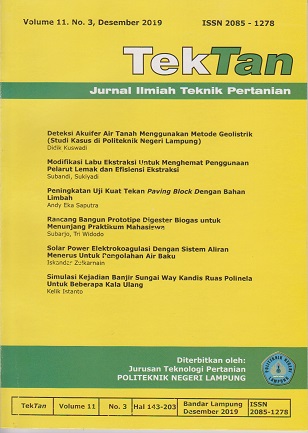Deteksi Akuifer Air Tanah Menggunakan Metode Geolistrik (Studi Kasus di Politeknik Negeri Lampung)
DOI:
https://doi.org/10.25181/tektan.v11i3.1465Abstrak
In fact, the interpretation of groundwater potential is not as easy as it is predicted, even often quite difficult and requires elaborate equipment. This remembers the formation and movement of groundwater in nature, so that measurements cannot be carried out directly. Interpretation of groundwater potential will always include two main objectives, namely: (1) soils or rocks as a medium where groundwater is acquired, and (2) groundwater as a liquid that fills the cavity in the soil or rocks. Some ground level investigation methods that can be done, including: Geological method, Gravity method, Magnetic field method, seismic method, and Geoelectric method. From these methods, the Geoelectric method is a very widely used method and the result is quite good. These geoelectric estimates are intended to obtain an overview of the subsurface of the soil and the possibility of groundwater and minerals at a certain depth. These geoelectric estimates are based on the fact that different materials will have different types of prisoners when they are electrically flowing. Groundwater has a lower type of prisoner than mineral rocks. The objectives of the study are: (1) Identifying soil layer formations and precise drilling depth at points of observation, (2) creating a map of groundwater layer depth distribution (groundwater contour). The stages of this study, namely: (1) equipment preparation, (2) The conjectives of the type of prisoner geoelectric with Schlumberger configuration, (3) The collection of field data, (4) Analysis and interpretation of field  data. Based on the results of analysis and discussion, can be concluded several things, namely: (i) water carrying layer in location I (TG-01) is suspected to be found in the TUFA layer of Andesit with a depth of 25-61 meters and a layer of andesite Breksi with a depth of more than 61-100.0 meters, (ii) flow of water through intergrain space and cracks/gaps with the potential of small water/until moderate.Unduhan
Referensi
Ali, M.N., Za’ari dan Supoyo, 2003. “Eksplorasi, Eksploitasi Sumber Daya Mineral Air Bawah Tanah : Studi Kasus Di Kawasan Industri Pasuruan Jawa Timurâ€. Proceedings of Joint The 32nd IAGI dan The 28th HAGI Annual Convention and Exhibition.
Azhar dan Handayani G., 2004. “Penerapan Metode Geolistrik Konfigurasi Schlumberger untuk Penentuan Tahanan Jenis Batubara“. Jurnal Natur Indonesia.
Badan Perencanaan Pembangunan Daerah (Bappeda) Kota Bandar Lampung. 2010. Rencana Tata Ruang Wilayah Bandar Lampung Tahun 2011 - 2030, Bappeda Kota Bandar Lampung. Bandar Lampung.
Bisri, M. 1991. “Aliran Air Tanah Malang“, Fakultas Teknik Universitas Brawijaya.
Derana, T. I., 1981, “Perbandingan Interpretasi Geolistrik“, Aturan Wenner dan Schlumberger, Skripsi, Jurusan Geologi Fakultas Teknik Universitas Gadjah Mada, Jogjakarta.
Dobrin, B.M., and Savit, C.H., 1988, Introduction to Geophysical Prospecting, 4Th ed., Mc Graw Hill Bool Company.
Fetter, C.W. 1980. Applied Hydrogeology. Charles E. Merrill Publishing Company. London.
Gusfan, H. dan Jojok, W.S.2008. Pendugaan Potensi Air Tanah dengan Metode Geolistrik Konfigurasi Schumberger di Kampus Tegal Boto Universitas Jember. https://www.researchgate.net/publication/266373903.
Mangga, S.A., Amiruddin, Suwardi, T., Gafoer, S. & Sidarto, 1993. Geologi lembar Tanjung Karang, Pusat Penelitian dan Pengembangan Geologi.
Meer Mohr, H.D. 1985. Photo Interpretation for Geology (Lecture Note). ITC Enchede. The Netherlands.
Linsley, R.K. and Franzini, J.B. Water Resources Engineering. McGraw-Hill Inc. Tokyo.1972.
Sains MIPA Volume 18 Nomor 1 Tahun 2018. Universitas Lampung. Bandar Lampung.
Sheriff, R E., 2002, “Encyclopedic Dictionary of Applied Geophysics, 4th edition“, SEG Tulsa, Oklahoma.
Suharyadi. 1984. Geohidrologi (Ilmu Air Tanah). Jurusan Teknik Geologi. Fakultas Teknik. UGM. Yogyakarta.
Sukardi, P. 1984. Air Tanah. Sub Unit Hidrogeologi. Direktorat Geologi Tata Lingkungan. Bandung.
Suroto. 1985. Penyelidikan Evaluasi Potensi Air Tanah Daerah Labuan Jawa Barat. Direktorat Geologi Tata Lingkungan. Bandung.
Telford, W. M., Geldart, L. P. and Sheriff, R. E., 1990, “Applied Geophysics, Second Edition“, Cambridge University Press, United State of America.
Todd, D.K. 1980. Groundwater Hydrology. John Willey and Sons Inc. New York.
Walton, W.C. 1970. Groundwater Resources Evaluation. McGraw-Hill Company. New York.
Winarti , 2013. Metode Geolistrik untuk Mendeteksi Akuifer Air tanah di Daerah Sulit Air (Studi Kasus di Kecamatan Takeran, Poncol dan Parang Kabupaten Magetan). http://stta.ac.id/data_lp3m/winarti.pdf
Winarti dan Joko, S, 2013, Studi Geolistrik Untuk Mengetahui Akuifer Airtanah di Desa Bajulan, Kecamatan Loceret, Kabupaten Nganjuk, Seminar Nasional SNTEKPAN 2013, ITAT Surabaya



